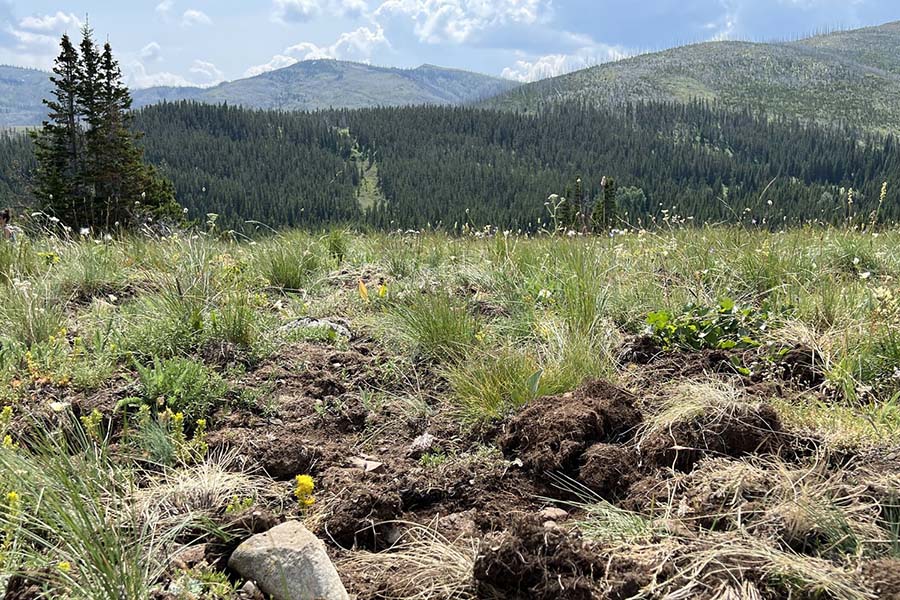
By Peter Metcalf
Executive Director

Emergent Threats to the Badger-Two Medicine and other Public Lands in the Central Crown of the Continent
Since taking office on Jan. 20th, the Trump Administration has issued a seemingly endless sequence of policy directives or executive actions aimed at dramatically expanding natural resource extraction from federal public lands or weakening their conservation management. This week, an emboldened far-right wing in the Montana state legislature got into the act when it introduced two resolutions, one to eliminate protections for millions of acres of public lands in Montana, including parts of the Badger-Two Medicine, and another supporting Utah’s quixotic effort to transfer millions more to the states where they could be sold or privatized.
It’s a lot to take in, even for the most ardent observer. We’re here to help. This post provides a brief summary of the emergent threats to public lands in the central Crown of the Continent, including to the Badger-Two Medicine and Glacier National Park, as well as what GTMA is doing to defend these beloved wild places.
Devastating Staffing Cuts to the Park Service, Forest Service and other Federal Agencies
The most consequential action so far has been the on-going, mostly indiscriminate reductions in staff for Glacier National Park, the Helena-Lewis and Clark and Flathead National Forests, the US Fish and Wildlife Service, and the US Geological Survey.
The most significant cuts so far occurred February 14th when nearly all probationary employees were terminated (probationary employees typically have less than 1-year in their current position, though they may have worked for decades for the agency). Nearly the entire staff of the Spotted Bear Ranger District was let go as was nearly the entire trail crew for the Rocky Mountain Ranger District. This crew had just been rebuilt, thanks to funding from Great American Outdoors Act (sponsored by Steve Daines), and had made impressive gains catching up on years of deferred trail clearing and recreation maintenance. Now that progress is in peril.
Although recent court orders have directed the agencies to reinstate terminated probationary employees while legal challenges move forward, the rate of return has varied, with some staff we’ve talked to still not sure if, or when, they will actually return to work. Meanwhile, a still unknown number of employees have taken Elon Musk’s deferred resignation or other federal voluntary separation or early retirement offers, with more expected to do so as the agencies work through a Reduction in Force process over the next month. How the reduction will affect our local agency branches is unclear as is the breadth of the cuts. A leaked memo from the Office of Personnel called for a 30% reduction in force at the National Park Service.
The staffing cuts threaten to undermine every aspect of the agencies work – such as basic visitor services like clearing trails and maintaining roads, fighting fires (although fire fighters were exempted, firefighting operations depend heavily on other agency staff), or conducting scientific research critical to effective management and conservation. The long-term impacts to the agencies, and the lands and resources they manage, is likely to be severe due to lost expertise, experience, and institutional knowledge as seasoned veterans leave the service, or from loss of promising young professionals now-dissuaded to pursue a career in public service.
More immediately, the cuts have hindered the ability of the Glacier to prepare for and manage the more than 3 million people expected to visit again this year (due to federal staffing cuts and a month-long hiring freeze on seasonal workers, Glacier only has about 1/3 of its summer work force hired so far, though the Park thinks it will have the needed personnel in place by the time the bulk of the season hits.). At last check, the Forest Service has reinstated probationary employees, though it's far from clear they will still be on the payroll come summer.
The chaotic process has been cruel and left staff fearful and demoralized. The pressure campaign is a clear attempt to undermine effective management as a pretext to dismantle the agencies. Our public lands, our wildlife, and the people who manage them deserve better.
GTMA continues to call on our elected officials to prevent further cuts to our local agencies or their budgets, and to ensure these agencies are have the staff and resources needed to effectively manage the lands, waters, and wildlife they are responsible for.
The Specter of Renewed Oil and Gas Production
Many people are rightly worried what the flurry of orders to increase oil and gas extraction from federal public lands portends for the Badger-Two Medicine and Rocky Mountain Front. The administration’s actions are unlikely to have much effect locally unless Congress gets involved. This is because Congress withdrew all federal lands in this area from oil and gas or mineral exploration in 2006. And with your help, all oil and gas leases have been subsequently been eliminated! Before any new leases could be issued, Congress would have to re-open these lands to leasing or mineral exploration. GTMA is vigilantly monitoring for any sign Congress may consider opening any of the withdrawn lands again to oil and gas or mineral exploration.
Back to the 1960s: Logging as the Dominant Use of National Forest Lands
On March 1st, Trump issued a pair of Executive Orders aimed at accelerating logging on national forests lands under the guise of a faux national security crisis supposedly created by the import of lumber from Canada. Executive Order 14225, entitled “Immediate Expansion of American Timber Production” directs the Forest Service and BLM “to fully exploit” public forest lands to increase the nation’s domestic timber supply. To do so, it directs the agencies to eliminate federal rules and regulations that impede logging projects, including regulations that ensure science-based decision-making, protect fish and wildlife, or safeguard clean drinking water. In effect, this sweeping order prioritizes logging or over all other uses of national forest lands, and threatens to take us back to the days when you couldn’t see the forest for the stumps.
Although the orders set a clear direction for the Forest Service to follow, the effect the orders will actually have on local forest management is far from certain. Rolling back regulations is often time intensive. Developing timber sales requires staff, staff the agency may no longer have. There is also substantial uncertainty whether local mills have the capacity to process more logs (some timber sales already go unfulfilled on the Flathead National Forest, for example). And many areas of the national forest, such as the Badger-Two Medicine, are classified in Forest Plans as unsuitable for timber production, at least for now.
Most immediately concerning is the directives, many of them legally dubious at best, to minimize or circumvent Endangered Species Act or the National Environmental Policy Act review for logging projects. These actions not only ignore critical environmental safeguards, they would severely limit public participation in decisions and design of future logging projects.
Forest and Park Planning Processes To Continue, Mostly
One of the key ways GTMA works to improve the conservation and management of our national forest and park lands, including protection of fish and wildlife habitat, is through agency planning processes. We are currently engaged in substantive planning processes to expand prescribed fire to improve ecological conditions on the Helena-Lewis and Clark National Forest, develop a new Comprehensive River Management Plan for the Wild and Scenic Forks of the Flathead River, and or manage exploding visitor use to Glacier National Park, amongst others. From what agency personnel tell us, all these planning processes remain on track, at least for now. However, whether the agencies will still have the requisite specialists and planning staff to continue these or other important projects is far from certain.
Frozen Funding Shows Signs of a Spring Thaw
The Trump Administration’s freezing of federal grants and contracts pending review for alignment with their policies and priorities, including money for work already completed and owed to private businesses, has substantially impacted many conservation organizations' bottom line or the ability to plan for the upcoming field season. Thankfully GTMA has mostly avoided the financial effects, as our work is almost entirely supported by individual donors and private foundations. However, it has cast some uncertainty over the work we’re doing with Piikani Lodge Health Institute to get youth, especially Blackfeet youth, out on the land, as well as engage the broader community in stewarding the Badger-Two Medicine. It has also called into question whether we will be able to offer our annual volunteer trip with the Bob Marshall Wilderness Foundation to clear trails. These projects are largely supported by federal funding our partners receive. Impacted partners report some indications that money is starting to move again, so the delay may ultimately prove to be a frustrating waste of people’s time and energy, rather than a meaningful change in the delivery of promised funds.
Far-right State Legislators Seek to Strip Protections or Transfer Federal Public Lands
Once again, far-right Republicans in the state legislature are trying to strip established protections from public lands or transfer them out of federal ownership. House Joint Resolution 24 would direct Montana to support the state of Utah in its quixotic attempt to transfer certain federal lands to the state of Utah, on the basis that the federal ownership is unconstitutional, a claim that has been repeatedly rejected by the courts and legal scholars. This resolution is a precursor of attempts to do likewise in Montana.
More concerning is Senate Joint Resolution 14 which asks Congress to eliminate one million acres of Wilderness Study Areas on National Forest and Bureau of Land Management lands in the state, as well as get rid of the 2001 Roadless Area Conservation Rule that protects 6 million acres of National Forests from new road construction or commercial logging. About 70% of the Badger-Two Medicine is protected by the Roadless Rule, as well as most of the Skyland / Challenge area and lands along the Middle Fork drainage outside the Great Bear Wilderness on the Flathead National Forest. Roadless areas like the Badger-Two Medicine provide some of the best, most secure wildlife habitat on public lands. They also protect healthy, intact watersheds, which are often critical sources of clean water for downstream communities or agriculture. These and many other environmental, cultural or recreational benefits roadless areas provide are at risk should the Congress eliminate the rule as SJ 14 asks them to do.
GTMA testified against the bill, as did many of our supporters, and will continue to fight back against any and all attempts to weaken protections for the Badger-Two Medicine or other adjacent public lands.
